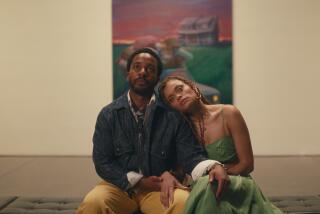Andy Warhol’s screen-test factory
- Share via
Master conceptualist and founding father of modern celebrity culture, Andy Warhol was also, for a spell in the 1960s, the most prolific filmmaker in America.
From 1963, when he acquired his first camera, to 1968, when he was shot and nearly killed by the radical feminist Valerie Solanas, Warhol made hundreds of films, home movies of a sort, the most elemental of which took the form of a so-called screen test.
Warhol’s films remain overshadowed by his fine art, largely because the artist withdrew the work from circulation in 1970. But for a couple of years in the mid-’60s, any visitor to the Factory, his mythic Manhattan studio, who was deemed sufficiently interesting was invited to sit before Warhol’s tripod-mounted, 16-millimeter Bolex, look into the lens and try to remain as still as possible as the camera rolled -- to pose, in effect, for a living portrait.
A release due out Tuesday, “13 Most Beautiful . . . Songs for Andy Warhol’s Screen Tests,” issued by Plexifilm in conjunction with the Andy Warhol Museum, is the first authorized DVD of Warhol films.
The 13 tests contained here span a representative range of subjects, from celebrities ( Lou Reed, Dennis Hopper) to Warhol-created stars (Edie Sedgwick, Baby Jane Holzer) and unknowns. Each is scored to new music by Dean Wareham and Britta Phillips, formerly of the band Luna; a few songs are covers, most are originals, and all are conducive to languid reverie. The tests also can be played without music.
As a filmmaker, Warhol was a poet -- and a provocateur -- of duration. His most famous movies are fabled for their epic lengths: “Sleep” (1963), a five-hour portrait of his slumbering then lover, a young poet named John Giorno; “Empire” (1964), an eight-hour static shot of the Empire State Building, as day creeps almost imperceptibly into night.
His screen tests are much shorter, but they were also, in sum, a monumental project. He made nearly 500 in all, and they add up to what the Warhol expert Callie Angell, author of a superbly detailed monograph on these films, has called “the yearbook of the mid-1960s avant-garde.”
Each test lasted as long as a single 100-foot roll of film. Each was shot at 24 frames per second and projected at two-thirds of that speed, a trick Warhol often used. Each took a little less than three minutes to film, and takes a little more than four to watch. The slow-motion effect adds a discernible flicker, heightens every movement and contributes to the dreamy, ghostly quality.
Some sitters turn on the charm; others react awkwardly. Not surprisingly, the most famous brim with attitude. Dennis Hopper bops to an unheard song, smiles at a private joke. Nico, accompanied by “I’ll Keep It With Mine,” a Bob Dylan number that she supposedly inspired and later covered on “Chelsea Girl,” barely deigns to acknowledge the camera, ducks in and out of the frame, plays with her hair, gazes into the distance.
A few posers rely on props: Lou Reed, in shades, swigs from a bottle of Coke; in a strained bit for irony, the chosen song is the Velvet Underground’s “I’m Not a Young Man Anymore” -- while Holzer suggestively brushes her teeth.
The most startling tests are, in some ways, the most minimal. As she did in all her screen appearances, the doomed Sedgwick, Warhol’s ultimate muse, conjures instant drama with the slightest movement of her facial muscles, the merest widening or narrowing of her large, endlessly expressive eyes.
Ann Buchanan, a member of the Beat poetry set, is the rare subject who actually heeds the instruction not to move or blink, and the strain causes her to shed a slowly rolling tear.
To watch a series of screen tests in a row is to be struck by the infinite room for deviation within this fixed format. The setups are similar, but the lighting often changes dramatically from one film to another; some faces are partly in shadow.
The greatest variety, of course, can be found in the wondrous range of performances -- in how each poser responds to the quandary of self-presentation and the degree to which the line is blurred between acting and being.
More to Read
The biggest entertainment stories
Get our big stories about Hollywood, film, television, music, arts, culture and more right in your inbox as soon as they publish.
You may occasionally receive promotional content from the Los Angeles Times.










